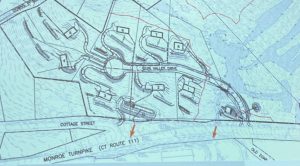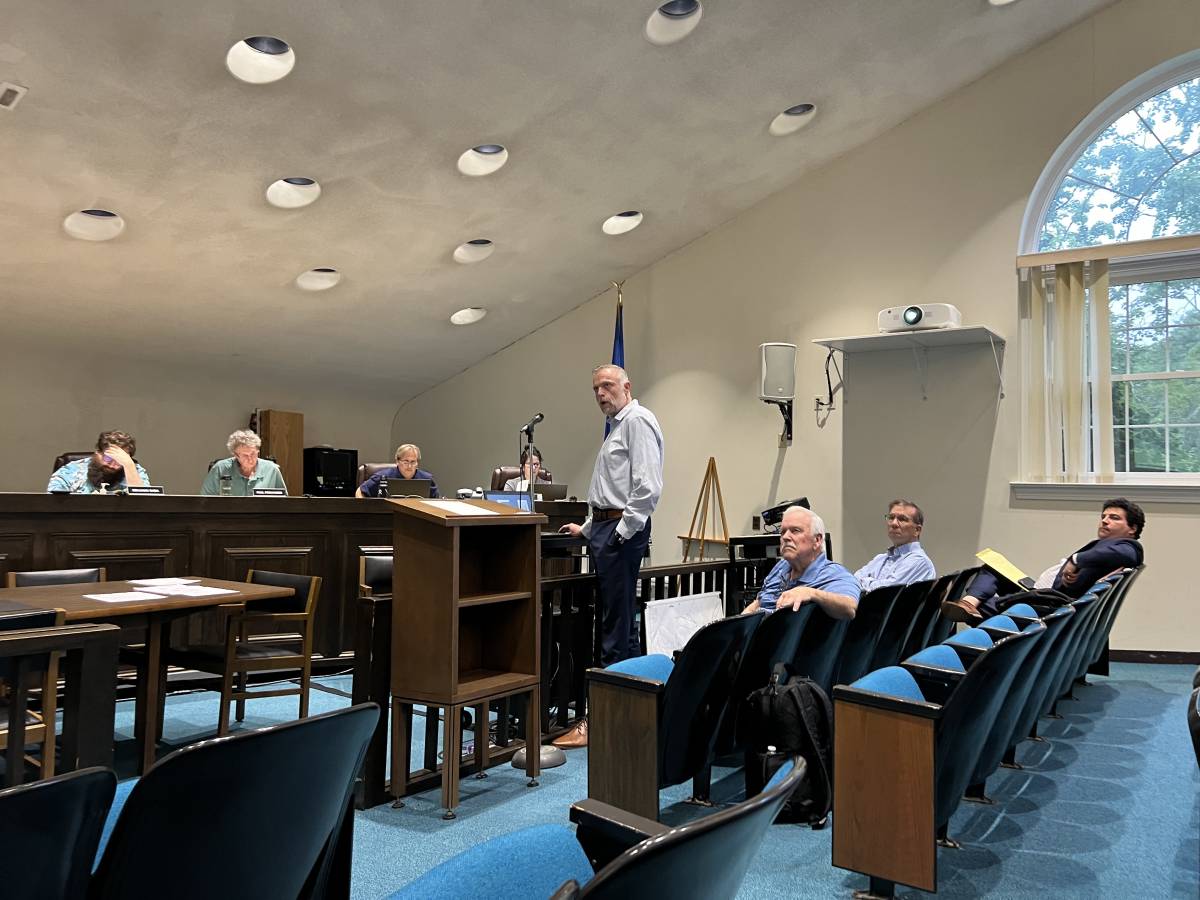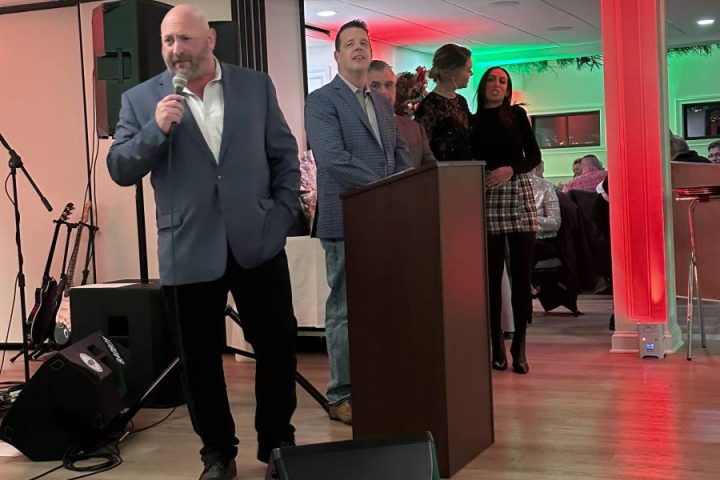MONROE, CT — A developer plans to build Sun Valley Glen, an eight lot residential subdivision at 1536 and 1564 Monroe Turnpike, across from the former Stevenson Lumber property. The proposal calls for cluster housing with the homes built on smaller 1.5 acre lots, while preserving 30 percent, rather than 15 percent, of the 34-acre site as open space.
Most of the parcels are zoned for residential-farming, which allows two acre lots, though a small corner is zoned Business-2.
Jason Edwards, principal of J. Edwards and Associates, an engineering and surveying firm based in Easton, said 12.5 acres, with frontage on Manor Drive, would be preserved as open space and another five acre parcel would remain undeveloped “at this time.”
The main concern expressed by Inland Wetlands commissioners at the hearing Wednesday night is construction of a new road, Sun Valley Drive, which would cross over wetlands at the entrance, across from Old Zoar Road.
The applicant says 2,800 square feet of wetlands would be disturbed but Planning and Zoning Administrator and Town Engineer James DiMeo put that number at 3,800 to 3,900 square feet.
Edwards said they considered several alternatives for the location of the entrance, but town and Connecticut Department of Transportation regulations would not permit either option.
Commissioner Ryan Kelly said he was not doubting the testimony, but asked if it was possible for commissioners to see the regulations to help him understand the issues better.
Commissioner Benjamin Sabia expressed concern over how long it would take to build a four-sided box culvert, which is part of the application, which he believed could be detrimental for the area, impeding the flow of water and movement of wildlife.
Michael Czesnowski, of Jans Land Development LLC, which is the applicant, said the culvert could be built in one day.
Commissioner Rick Smith read his notes from a site walk into the record. He asked if the road entrance could be moved near Cottage Street, but was told it is not feasible.
“I want to push Cottage Street, because I’m not happy with the disturbance of 3,800 square feet of wetlands,” Smith said, adding another concern about the culvert reconfiguring the wetlands.
“Since the only impact is the crossing, I would like to see a less impact alternative,” Commissioner James Stewart said.
“I’m with these guys. Can we find another path that isn’t as impactful?” Acting Chairman Erik Lindstrom asked. “Let’s see what those regulations are. Maybe there’s a way to thread the needle, so we don’t have to have that wetlands impact.”
Lindstrom asked the applicant’s team of experts to try to come up with something a little better, which he said would make commissioners’ jobs a little easier.
Czesnowski told the commission the town requires roads to be 32 feet wide, but the narrowest it had approved was 28 feet for Deer Meadow Estates, a subdivision he had successfully applied for years ago, and where he has lived since 1994. The road is Whitetail Drive.
“We asked the town to let us do 26 feet, which is sufficient for an eight lot subdivision,” Czesnowski said of a request to decrease the disturbance of the wetlands. “But the town engineer indicated he will not support the changes.”
Jans Development initially had brought a different application for a nine lot subdivision last spring, before withdrawing it in mid-March. While revising the plan, Edwards said they removed one lot, which was the only one within the upland review area.
Environment
 Czesnowski said the dedicated open space would ensure critical areas of the watershed continue to do its functions.
Czesnowski said the dedicated open space would ensure critical areas of the watershed continue to do its functions.
He said their application has the support of NEMO (Nonpoint Education for Municipal Officials), which provides information, education and assistance to local land use boards and commissions on how to accommodate growth, while protecting natural resources and community character.
Dr. Steven Danzer, an environmental expert hired by the applicant, walked the property on March 21 and wrote a letter verifying there were no vernal pools on the site.
Matthew Popp, of Environmental Land Solutions in Norwalk, studied the property and also said he found no vernal pools in his investigation.
The Connecticut Department of Energy and Environmental Protection’s National Diversity Data Base shows bubbles on a map to indicate locations of endangered species. If the Monroe Turnpike properties were within it, DEEP approval would be needed, but Czesnowski said it is not.
Popp said the upland site areas are “vegetated with red oak, red and sugar maple, hemlock, black cherry, black and yellow birch, Christmas fern, and wintergreen. Nonnative and invasive species seen on the property include Japanese honeysuckle, garlic mustard, and multiflora rose.”
Vegetation growing within the wetland areas include red maple, yellow birch, spicebush and skunk cabbage, he said.
Plantings proposed for the basins include native shade trees, understory trees, shrubs, and herbaceous plants within the wetland buffer for wildlife habitat and aesthetic purposes.
Large growing native shade trees are proposed within the development for wildlife habitat and aesthetic purposes. “Over time, these trees will shade the new roads which will aid to decrease thermal pollution within stormwater runoff,” Popp said.
Czesnowski said a New England seed mix will be used around the basin, which creates wild flowers. The same mix was used for Deer Meadow Estates, which he said never had any problems because they were always conscientious in performing maintenance with erosion controls.
He said the basin area became a breeding ground for tree frogs, and the property is home to ducks and deer.
Edwards said the site will be in compliance with all standards in 2024 stormwater manual. The plan also has sediment controls. The proposal includes a detention basin for stormwater discharge and a fire pond, which can be used by firefighters to protect homes in the event of a fire.
Neighborhood opposition
A total of 21 residents attended the hearing, whether in person or online. All who spoke requested an independent environmental survey for the project, as well as a low impact engineering study. Several also asked any commissioners who may have a conflict of interest in their relationship with the applicant to recuse themselves from this hearing, “so there is no appearance of bias.”
Paula Jelly, of Cottage St., listed endangered species she has seen in the area, as well as an eastern box turtle, which is on the concerned list. Jelly also asked if the proposal would allow the rest of the neighborhood use of the fire pond.
She joined other neighbors in their concerns over stormwater drainage potentially causing flooding onto other properties.
In a letter to the commission, Audrey Wellner, of Downs Road, noted how the applicant is following an old farm road for the driveway and wondered how such a road could handle the weight capacity of today’s vehicles, delivery trucks and town vehicles.
Wellner said plans show the new road comes in at a 45 degree angle downhill, which she said would be dangerous in the winter.
Jelly said Connecticut general statutes do not now allow a road over wetlands. “Please don’t build a road over these wetlands,” she said, adding her belief that the five years it could take to build the development could destroy the ecosystem for amphibians.
During the presentation, Edwards had mentioned a previous approval for four homes in 2000 as the properties changed hands over the years. But Jelly said the actual approval with conditions was for two homes and a shared driveway with a conservation easement.
Edwards said he based it on information from his colleague David Bjorklund. “I should have done my homework better,” he said.
Jelly wanted two Newtown Bee articles to be read into the record about a project Edwards was involved with, which chronicles concerns over road and erosion control issues. “They got away with bad behavior,” Jelly said. “If you let them get away with it, they’ll do it again.”
Christopher Russo, the attorney for the applicant, said the articles are not fair to consider because it is about a different property and because Edwards did not design the erosion control plan for it. Russo also pointed out that the Monroe applicant was not involved with that project at all.
Ryan Budris, of Manor Drive, said he and his wife have had serious water problems for three years and installed large drains because of water coming from a neighboring property. “We have water problems up there,” he said. “We have a drainage basin on our property, but all the water is from other places.”
His wife, Erin, said she shares neighbors’ concerns over wildlife, and expressed interest in long term maintenance plans for basins in Jans Landing Development’s proposal.
Edwards said the basins would be maintained by either the homeowner or a homeowners’ association, which could be outlined as part of a commission approval.
Donna Konkol, of Manor Drive, said the 12.5 acres of open space the developer is offering to the town is “unbuildable anyway” and said she thinks an environmental assessment should be done during wetter months.
Mark LaMont, of Downs Road, said construction on the property would impact on wetlands, potable water and destroy natural habitats.
Kelley Hangos-Carrano, of Scholz Road, said you cannot build a road over wetlands unless you are a farm and she expressed concerns over neighborhood wells.
“Who is responsible when my original 12 foot, hand-dug well is dry?” she asked. “The town?”
In addition to wells potentially going dry more often, Hangos-Carrano said she is concerned over fertilizer used by new homeowners affecting the water quality.
Czesnowski said most of the residents live above his property, so their wells should not be affected by the project, and said wildlife adjusted and is thriving at Deer Meadow Estates, his other development.
Revisions possible
The hearing will be continued on Aug. 28. In the meantime, Russo said, “we’ll look at some of these comments made to address them and maybe revise the plan.”
Czesnowski said his team has “two of the best environmentalists in the state” so the hiring of an independent expert is not necessary. Nevertheless, the commission decided to hire an expert for the application.
“I still think an independent study will make everybody feel a heck of a lot better,” Lindstrom said.
All respectful comments with the commenter’s first and last name are welcome.






